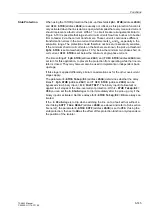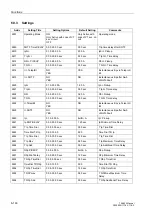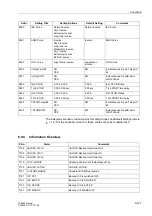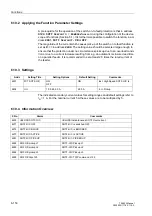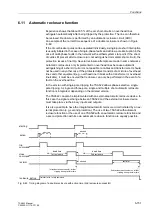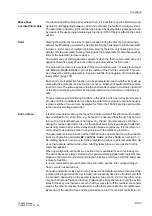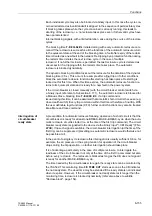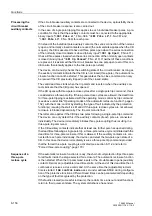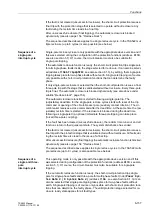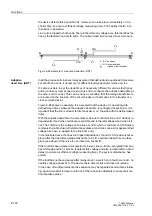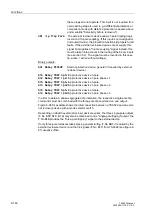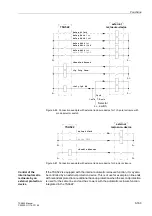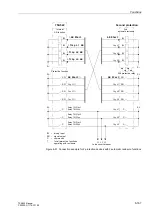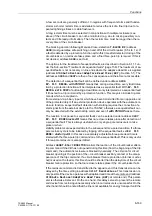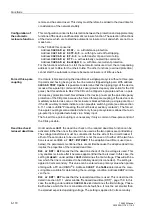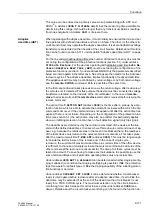
Functions
6-157
7SA522 Manual
C53000-G1176-C119-2
If the fault is not cleared (unsuccessful reclosure), the short-circuit protection issues a
final trip with the protection stage that is selected to operate without reclosure. Any
fault during the reclaim time leads to a final trip.
After unsuccessful reclosure (final tripping), the automatic reclosure is blocked
dynamically (see also page 154, "Reclose block").
The sequence described above applies to a single reclosure cycle. In the 7SA522 mul-
tiple reclosure (up to 8 cycles) is also possible (see below).
Sequence of a
single-pole
interrupt cycle
Single-pole reclose cycles are only possible with the appropriate device version and if
this was selected during the configuration of the protection functions (address
see also section 5.1). Of course, the circuit-breaker must also be suitable for
single-pole tripping.
If the automatic reclosure function is ready, the short-circuit protection trips single pole
for all single-phase faults inside the stage selected for reclosure. It can also be select-
ed (address
, see also section 6.1.3), by setting, that single-pole
tripping takes place for two-phase faults without earth. Single-pole tripping is of course
only possible with short-circuit protection functions that can determine the faulty
phase.
If only single-pole reclosure is selected then the short-circuit protection issues a final
three pole trip with the stage that is valid/selected without reclosure. Every three-pole
trip is final. The automatic reclosure is blocked dynamically (see also above under
subtitle "Reclose block", page 154).
The automatic reclosure function is started following a single-pole trip. The
(adjustable) dead time for the single-pole reclose cycles starts with reset of the trip
command or opening of the circuit-breaker pole (auxiliary contact criterion). The cir-
cuit-breaker receives a close command after the dead time. At the same time the (ad-
justable) reclaim time is started. If the reclosure is blocked during the dead time
following a single-pole trip, optional immediate three-pole tripping can take place
(forced three-pole coupling).
If the fault has been cleared (successful reclosure), the reclaim time runs out and all
functions return to their quiescent state. The system disturbance has ended.
If the fault is not cleared (unsuccessful reclosure), the short-circuit protection issues a
final trip with the protection stage that is valid/selected without reclosure. All faults dur-
ing the reclaim time also lead to the issue of a final trip.
After unsuccessful reclosure (final tripping) the automatic reclosure function is blocked
dynamically (see also page 154, "Reclose block”)
The sequence described above applies to single reclose cycles. In the 7SA522 multi-
ple reclosure (up to 8 cycles) is also possible (see below).
Sequence of a
single and three-
pole
interrupt cycle
This operating mode is only possible with the appropriate device version and if this
was selected during configuration of the protection functions (address
, see also
section 5.1). Of course, the circuit-breaker must also be suitable for single-pole
tripping.
If the automatic reclosure function is ready, the short-circuit protection trips single-
pole for single-phase faults and three-pole for multi-phase faults. Under
(address
, see also Section 6.1.3) it can
also be selected that single-pole tripping takes place for two-phase faults without
earth. Single-pole tripping is of course only possible with short-circuit protection func-
tions that can determine the faulty phase. The valid protection stage selected for re-
closure ready state applies for all fault types.
Summary of Contents for siprotec 7SA522
Page 20: ...7SA522 Manual C53000 G1176 C119 2 ...
Page 64: ...7SA522 Manual C53000 G1176 C119 2 ...
Page 89: ...SIPROTEC 4 Devices 4 25 7SA522 Manual C53000 G1176 C119 2 Figure 4 20 CFC Logic example ...
Page 408: ...7SA522 Manual C53000 G1176 C119 2 ...
Page 456: ...7SA522 Manual C53000 G1176 C119 2 ...
Page 516: ...7SA522 Manual C53000 G1176 C119 2 ...
Page 620: ...Appendix B 48 ...



